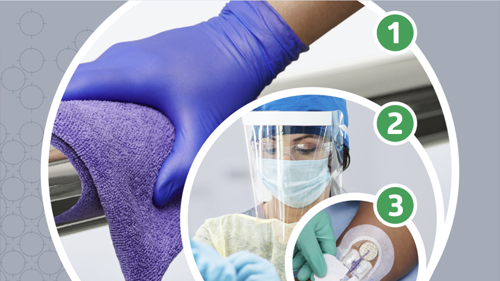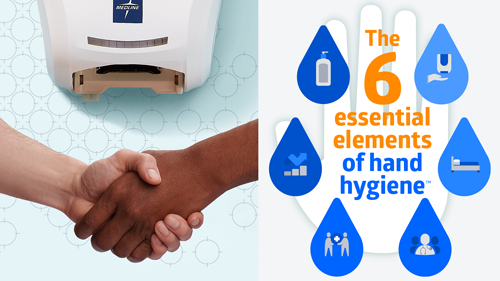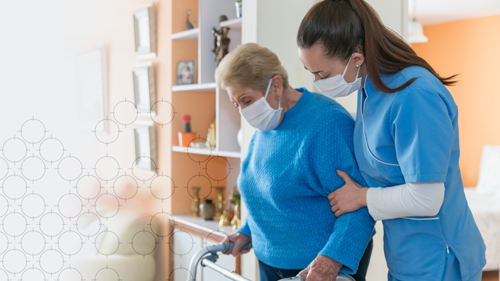F tags for nursing homes: How do you prevent CMS citations?
Reducing HAIs and keeping everyone safe is a shared responsibility.

A little background
It’s September 2016, and the Centers for Medicare & Medicaid Services (CMS) has just issued a final rule to improve the care and safety of the nearly 1.5 million residents in the more than 15,000 long-term facilities that participate in the Medicare and Medicaid programs. The policies in this final rule target reducing unnecessary hospital readmissions and infections, improving quality of care and strengthening safety measures for residents in these facilities.1
Among the many requirements for participation: Although the infection control section of the Final Rule was part of Phase 1 implementation, some provisions were scheduled for later, including:
- Phase 2—linking the Infection Prevention and Control Program (IPCP) to the facility assessment and developing an antibiotic stewardship program
- Phase 3—designation of the infection preventionist (IP) and the IP’s participation in the QAA (Quality Assessment and Assurance) Committee.
Phase 3 places greater emphasis on infection prevention, as well as coordination with all other functions within the facility.
Fast-forward to October 2019. Just weeks before the provision is scheduled to go into effect, CMS announces that they won’t issue guidance—and will limit enforcement—until the second quarter of 2020.2
That’s where things stood when COVID-19 hit the United States in March 2020. That year alone, CMS issued more than 11,800 citations to nearly 6,600 nursing homes for F-tag F880—infection prevention and control. And there were 7% more immediate jeopardies [for F880] in 2020 than there were in the prior two years.3
1 to 3 million
serious infections are estimated to occur every year in nursing homes, skilled nursing facilities and assisted living facilities4
In fact, F880 has been the number one citation for the past 10 years, only to fall to second in 2021, with F884—Reporting to the National Health Safety Network—taking the number one spot.5 Why are nursing homes being cited for these F-tags, and what steps can your facility take to avoid them?
F880 citations and how to avoid them
Per CMS, a surveyor conducting a COVID 19-focused survey of your facility will focus on the following areas:
- Standard and transmission-based precautions
- Resident care for COVID-19
- IPCP standards, policies and procedures
- Infection surveillance
- Visitor entry
- Education, monitoring, and screening of staff
- Staff and resident COVID-19 testing
- Suspected or confirmed COVID-19 reporting to residents, representatives and families
- Laundry services
- Antibiotic stewardship program
- Infection preventionist
- Influenza and pneumococcal immunizations
Of that list, the most frequent F880 citations nursing homes receive are for:
- Staff failure to consistently:
- Wash their hands
- Wear masks and other personal protective equipment (PPE)
- Don and doff gloves when entering and leaving resident rooms
- Cohorting (grouping) residents incorrectly6
We’ll tackle these one at a time.
It always comes down to hand hygiene
Here are the hand hygiene-related activities CMS will note when conducting an onsite survey:
- Appropriate hand hygiene practices (i.e., alcohol-based hand rub [ABHR] or soap and water) are followed
- Staff wash hands with soap and water when their hands are visibly soiled (e.g., blood, body fluids), or after caring for a resident with known or suspected C. difficile infection (CDI) or norovirus during an outbreak, or if endemic rates of CDI are high. ABHR is not appropriate to use under these circumstances.
- Staff perform hand hygiene (even if gloves are used) in the following situations:
- Before and after contact with the resident
- After contact with blood, body fluids or visibly contaminated surfaces
- After contact with objects and surfaces in the resident’s environment
- After removing PPE (e.g., gloves, gown, eye protection, facemask)
- Before performing a procedure such as an aseptic task (e.g., insertion of an invasive device such as a urinary catheter, manipulation of a central venous catheter and/or dressing care)
- When being assisted by staff, resident hand hygiene is performed after toileting and before meals. How are residents reminded to perform hand hygiene?
How do you motivate staff to comply with hand hygiene protocols? For both hand hygiene and PPE compliance, it’s crucial that staff understand the “why” in addition to the “what.” For example, “Here’s why you need to wear PPE when entering a resident’s room,” or “This is why you need to wash your hands after taking off your gloves.”
For hand hygiene, follow the six essential elements of hand hygiene:
- Advanced products. Select a standardized product formulary that is supported by sound science and developed for high-frequency hand hygiene.
- Reliable delivery systems. Align placement of product dispensers with CMS, Centers for Disease Control and Prevention (CDC), Joint Commission and World Health Organization (WHO) guidelines.
- Point of care access. Position hand hygiene products close to where hand hygiene moments occur.
- Effective learning systems. Provide targeted education and training tools (based on behavioral science, human factors and high-reliability organizational design) to make hand hygiene best practices second nature for all.
- Safety culture. Foster a safety culture that embraces leadership engagement, psychological safety and top-down accountability.
- Actionable feedback. Implement best practices for collecting and analyzing data and understand how to pinpoint where improvement is needed.
These elements are part of Medline’s Post-Acute Care Infection Prevention Program, which includes a risk assessment and toolkits covering hand hygiene, PPE and environmental services (EVS).
Protecting yourself with PPE
Here are the PPE-related activities CMS will note when conducting an onsite survey:
- Gloves are worn if potential contact with blood or body fluid, mucous membranes or non-intact skin
- Gloves are removed after contact with blood or body fluids, mucous membranes or non-intact skin (and hand hygiene performed)
- Gloves are changed and hand hygiene is performed before moving from a contaminated body site to a clean body site during resident care
- An isolation gown is worn for direct resident contact if the resident has uncontained secretions or excretions (e.g., changing a resident and their linens when excretions would contaminate staff clothing)
- Appropriate mouth, nose and eye protection (e.g., facemasks, goggles, face shield) along with isolation gowns are worn for resident care activities or procedures that are likely to contaminate mucous membranes, or generate splashes or sprays of blood, body fluids, secretions or excretions
- All staff are wearing a facemask (e.g., a cloth face covering can be used by staff where PPE is not indicated, such as administrative staff who are not at risk of coming in contact with infectious materials)
- When COVID-19 is present in the facility, staff are wearing an N95 or equivalent or higher-level respirator, instead of a facemask for aerosol generating procedures
- PPE is appropriately discarded after resident care, prior to leaving room (except in the case of extended use of PPE per national and/or local recommendations), followed by hand hygiene
- During the COVID-19 public health emergency, PPE use is extended/reused in accordance with national and/or local guidelines. If reused, PPE is cleaned/decontaminated/maintained after and between uses.
- Supplies necessary for adherence to proper PPE use (e.g., gloves, gowns, masks) are readily accessible in resident care areas (e.g., nursing units, therapy rooms)
To ensure compliance with appropriate use of PPE, ensure staff understand:
- When and why each item of PPE should be used
- Where each item should be used
- How to put on and remove each item
- What to do with items after removing them
- What hand hygiene is required after item removal
In addition, ensure that your facility has sufficient inventory of each item and that the items are stored properly.
“Up until COVID, the main PPE in long-term care facilities was gloves, with no budget for other equipment such as gowns, goggles and facemasks.”
Caryn Humphrey
Medline Medical Science Liaison
Consider using shift coaches
For both hand hygiene and PPE, shift coaches can raise compliance rates. Shift coaches are peers on each shift assigned to provide just-in-time coaching to peers and others about infection control practices.
Coaches speak up when they see something that’s “not right.” They observe and interact with staff that have already gone through training. Rotating coaches enables peers to coach one another.7
Cohorting (grouping residents) correctly
The most common reasons for immediate jeopardy (IJ) violations are:
- Not cohorting
- Waiting to cohort/take isolation precautions until test results return
- Incorrectly cohorting based on premature test results
- Having staff or residents move between units
- Not following infection prevention and control practices on the unit8
To prevent citations related to cohorting:
- Ensure you understand the incubation period for suspected infections
- Isolate a resident if an infection is suspected instead of waiting for test results
If a new resident is being transferred from an acute care facility, work with contacts at the hospital to ensure accompanying documents reflect all suspected or confirmed infections.
Are you the infection preventionist?
If you are the individual designated as the infection preventionist in your facility, you’ll want to check out the free “Nursing Home Infection Preventionist” training course, produced by the CDC in collaboration with CMS. This specialized nursing home training covers core activities of effective IPC programs and recommended IPC practices to reduce pathogen transmission, HAIs and antibiotic resistance.9
What about EVS?
Your facility’s environmental cleaning and disinfection protocols should be implemented within the framework of your infection prevention and control (IPC) program. It is also essential that IPC programs advocate for and work with facility administration and government officials to budget, and operate and maintain adequate water, sanitation and hygiene (WASH) infrastructure to ensure that environmental cleaning can be performed according to best practices.
Risk-based environmental cleaning frequency principles include:
- Probability of contamination: Heavily contaminated surfaces and items require more frequent and thorough environmental cleaning than moderately contaminated surfaces, which in turn require more frequent and rigorous environmental cleaning than lightly or non-contaminated surfaces and items.
- Vulnerability of residents to infection: Surfaces and items in care areas containing vulnerable residents (e.g., immunosuppressed) require more frequent and rigorous environmental cleaning than surface and items in areas with less vulnerable residents.
- Potential for exposure to pathogens: High-touch surfaces (e.g., bed rails) require more frequent and rigorous environmental cleaning than low-touch surfaces (e.g., walls).
Every facility should develop cleaning schedules, including:
- Person responsible
- Frequency
- Method (product, process)
- Detailed SOPs for environmental cleaning of surfaces and noncritical equipment in every type of care area
Checklists and other job aids will help you ensure that cleaning is thorough and effective.10
142,720
resident/staff deaths due to COVID-19 in long-term care facilities, as of November 21, 202111
F884 requirements and reasons for citations
Now that we’ve covered F880, let’s take a look at the F-tag with the most citations in 2021.
Since May 8, 2020, nursing homes have been required to report information related to COVID-19 directly to the CDC. The following information is required:
- Suspected and confirmed COVID-19 infections among residents and staff
- Total deaths and deaths related to COVID-19 infection, including both resident and staff deaths
- PPE and hand hygiene supplies
- Ventilator capacity and supplies
- Resident beds and census
- Resident access to testing
- Staffing shortages
Noncompliant nursing homes receive a per day civil money penalty (CMP) for one day assessed at $1,000. For each additional week the nursing home fails to comply with this requirement, the rate of the per day CMP increases by an additional $500.12
The citations most commonly issued are:
- Not all seven modules completed
- Not all data elements in module completed
- Waiting to submit on Sunday and then something goes wrong
- Having only one person registered for submissions
You can avoid CMPs by following the critical element pathways (CEPs). Surveyors follow a process that is specific and known. Guidance for infection prevention-related CEPs is available on the CMS site.13
Don’t forget OSHA inspections
Citations from other entities are possible as well. On June 10, 2021, the Occupational Safety and Health Administration (OSHA) issued the COVID-19 Healthcare Emergency Temporary Standard (ETS), which requires healthcare employers to follow safety and infection prevention requirements related to COVID-19. The ETS addresses policies and procedures, PPE, administrative controls and engineering controls to reduce the risk of infection.
OSHA has announced plans to target onsite inspections in hospitals, assisted living complexes, nursing homes and other facilities treating patients with COVID-19. The inspection will include a program and document review, as well as a facility walkthrough. Citations may be issued if a facility lacks a COVID-19 plan and if other requirements of the standard have not been implemented. Each component failing compliance can be cited as a separate violation.
Your facility should perform an internal audit of your current IPCP to determine if it complies. Some requirements of the regulation are specific to COVID-19 and will need to be addressed, such as the mini-respiratory protection program, paid leave requirements, and additional training, recordkeeping and reporting obligations.14
Everyone in your facility plays a role in keeping people safe from infection—from staff to residents to visitors. We know it’s tough to meet increasing regulations when you already have competing priorities, limited resources and a high labor shortage. That’s why it’s so important that your facility’s leaders provide best practice guidance and ensure access to the right education, training and products.
Key takeaway
Leadership and staff at long-term care facilities face everyday challenges unique to post-acute care. Those challenges were escalated with the arrival of COVID-19. With limited resources, staff shortages and increased regulations, it can be difficult to ensure that infection prevention and control protocols are consistently followed. By assessing your facility’s risk level, providing training and education for management and staff, and employing best practices that promote shared accountability, you will be better positioned to keep everyone safe and avoid citations.
References:
- cms.gov. CMS finalizes improvements in care, safety and consumer protections for long-term care facility residents. September 28, 2016.
- Marselas, Kimberly. Long-term care remains in the dark about infection preventionist requirements. McKnight’s Long-Term Care News, April 13, 2021. Available at: https://www.mcknights.com/news/long-term-care-remains-in-the-dark-about-infection-preventionist-requirements/
- Flynn, Maggie. Infection Control Immediate Jeopardy Citations Tripled in 2020—and Nursing Homes Should Expect More. Skilled Nursing News, April 4, 2021. Available at: https://skillednursingnews.com/2021/04/infection-control-immediate-jeopardy-citations-tripled-in-2020-and-nursing-homes-should-expect-even-more/
- Centers for Disease Control & Prevention (CDC), Nursing Homes and Assisted Living (Long-term Care Facilities [LTCFs]). Available at: Long-term Care Facilities | CDC. Accessed November 19, 2021.
- Gifford, MD, MPH, David. How to Avoid Infection Control-Related Deficiencies. American Health Care Association/National Center for Assisted Living 72nd Convention & Expo, October 12, 2021.
- Ibid
- Ibid
- Ibid
- CDC, Nursing Homes and Assisted Living (Long-term Care Facilities [LTCFs]), Infection Prevention Training. Available at: https://www.cdc.gov/longtermcare/training.html. Accessed December 1, 2021.
- Best Practices for Environmental Cleaning in Healthcare Facilities: in Resource-Limited Settings, Version 2. CDC, 2019. Available at: Best Practices for Environmental Cleaning in Healthcare Facilities: in Resource-Limited Settings Version 2 (cdc.gov)
- CMS, COVID-19 Nursing Home Data. Available at: COVID-19 Nursing Home Data – Centers for Medicare & Medicaid Services Data (cms.gov). Accessed December 8, 2021.
- Eyigor, Jodi. CMS Releases Guidance Ahead of Nursing Home Reporting. LeadingAge, May 7, 2020. Available at: CMS Releases Guidance Ahead of Nursing Home Reporting | LeadingAge
- Gifford, MD, MPH, David. How to Avoid Infection Control-Related Deficiencies. American Health Care Association/National Center for Assisted Living 72nd Convention & Expo, October 12, 2021. CMS CEP guidance available at: Nursing Homes | CMS
- Solomon, Shari. OSHA Increasing Inspections in Healthcare Facilities. Healthcare Facilities Today, October 19, 2021. Available at: OSHA Increasing Inspections in Healthcare Facilities – Infection Control (healthcarefacilitiestoday.com)





